
All the herbal ley mixtures in this section are suitable for use as four-year leys where it is usual to break the ley after four years. Three years is too short a period in which to derive maximum benefit either in yield of grass or soil fertility; and I consider four or five years the optimum life. Each mixture is, however, basically also a permanent pasture mixture, so may be left down longer if necessary.
The quantities of seeds making up the mixtures are the ideal for quick establishment and soil coverage; but where extra economy is necessary in seasons of high-priced seeds, the eventual pasture, though slower to 'fill up', will be ultimately just as good with up to a third less seed, thus reducing the cost by one-third. But soil conditions, seedbed and fertility must be perfect for this reduction of seed quantity.
EARLY-GRAZING HERBAL LEY
(which also produces well throughout the summer)
lb. per acrePerennial Ryegrass, S.24 3 Irish or Ayrshire Ryegrass 3 Cocksfoot Danish 4 Cocksfoot S.191 4 Short Rotation Ryegrass, New Zealand H.1 6 Clover, S.100 1 Broad Red Clover 2 Meadow Fescue, S.215 4 Tall Fescue 2 Chicory (Cichorium intybus) 3 Sheep's Parsley (Petroselinum sativuni) 2 Lucerne 2 American Sweet Clover (Melilotus Alba) 2 Ribgrass or long-leaved Plantain 2 Caraway (Carum Carvi) 1 Broad-leaved Plantain (Plantago major) 1 ---42
This is the mixture of grasses and herbs which I have found give the earliest growth of the spring. Getting 'early bite' is usually reckoned to be largely a matter of laying on the nitrogen. Many farmers have fallen for this fallacy and themselves provided 'early bite' for the fertilizer salesmen. Once bitten, the more careful and intelligent farmers are twice shy of the soft, watery-growth admittedly earlier to come to the cow's mouth, but so often faster to flow from just beneath her tail. Scouring cows benefit little from this expensive form of protein-poisoning —and the slow subsequent growth from a ley which has been forced with nitrogenous fertilizers for the much-boosted 'early bite' makes it as wasteful of the farmer's cash as it is of the cow's health.
Wholesome, substantial and nutritious early bite may be obtained from a specially selected seeds mixture grown in one of the more sheltered fields of the farm, given if possible a light dressing of organic manure in the winter—or a thin sprinkling of straw to act as a gentle cloche to keep the grass warm and give it an early start.
Early bite obtained in this way will not scour the cows or rob the field of its ability to recover quickly after being grazed, and will maintain reasonable growth without expensive stimulants during the rest of the year.

34. Chicory
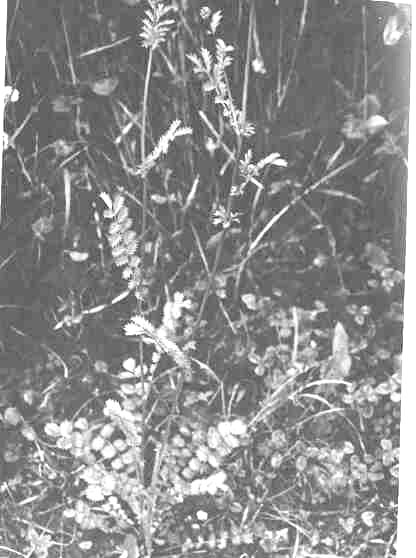
35. Burnet
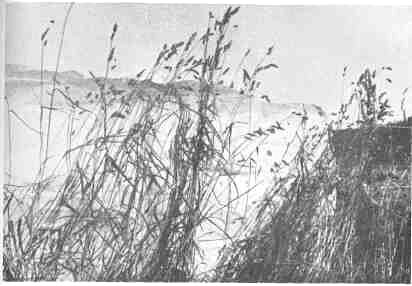
36. Cocksfoot
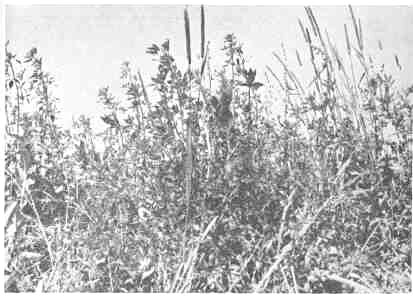
37. Lucerne (Alfalfa) and Timothy grass
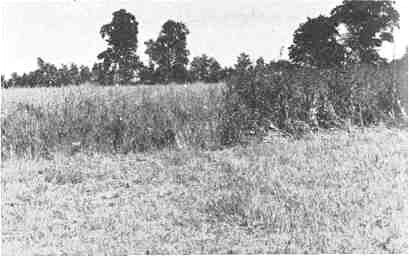
38. On the right, deep-rooting herbal ley mixture on land formerly incapable (because of stone and rock near surface) of growing a corn crop--see poor oat crop on left
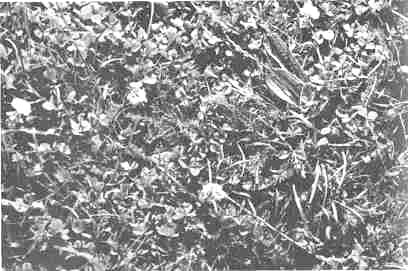
39. A close up of a fertility pasture showing yarrow and plantain among the clovers and grasses
MIDSUMMER-GRAZING HERBAL LEY MIXTURE
(For July and August Summer Growth)
lb. an acreLucerne 6 Chicory 6 Timothy, S.48 3 Timothy, S.50 3 S.100 Clover 1 Burnet (Poterium sanguisorba) 3 Late-flowering Red Clover 2 Meadow Fescue, S.53 4 Perennial Ryegrass, S.101 6 Perennial Ryegrass, S.23 6 American Sweet Clover 2 Sheep's Parsley 2 Caraway 1 Ribgrass (Long-leaved Plantain) 1 Broad-leaved Plantain 1 --- 47
Though this mixture is at its best in the semi-drought conditions of midsummer, and provides maximum grazing during the period of grass shortage on most farms, it does also provide good grazing throughout the normal growing season. The inclusion of an unusually high seeding of Chicory, and rather more of the deeper-rooting legumes, Lucerne and Sweet Clover, gives it remarkable powers of recovery after grazing during a period of drought.
It is best, therefore, grazed or mown during May and early June—being left to receive its heavy grazing in July and August, August when less specialized mixtures show little or no growth.
HERBAL LEY MIXTURE FOR AUTUMN
AND WINTER GRAZING
lb. an acre Cocksfoot, S.26 4 Perennial Ryegrass, S.23 8 Timothy, S.48 6 Red Fescue, S.59 3 Ribgrass (Long-leaved Plantain) 2 S.100 1 Chicory 2 Lucerne 2 Caraway 1 Broad-leaved Plantain 1 Burnet 3 --- 33
Though there has in recent years been quite a vogue for what is called 'foggage' for winter grazing, my experience has been that this coarse brown growth which results from leaving August and September growth for winter grazing has little more than belly-filling value. It is no good for milk-production or fattening when it has become so fibrous, colourless, and dry as foggage does from the Cocksfoot usually predominant ley used for that purpose.
The above mixture is chosen from grasses and herbs which I have observed growing later into the autumn and winter than other varieties or strains. If rested from mid-September this mixture will remain green and growing (if only slightly) through the winter, except in the most exposed positions.
The most important factor in achieving winter growth is a high organic content in the soil to maintain a higher temperature. If possible, give a light dressing of organic manure—say five tons to the acre of compost, or 3 to 5 cwt. to the acre of a more concentrated sewage powder or seaweed fertilizer (or combination of the two) before resting the field in September. This will set in motion the vigorous bacterial activity which creates the warmth and nutriment necessary to winter growth. In any case, allow a three-inch growth during the summer to be mown and left to lie on the surface. This will act as a cloche to warm the soil and feed the winter growth, while it slowly decomposes around the roots of the new green growth that is so valuable in the winter.
HERBAL LEY MIXTURE FOR VERY THIN, DRY SOILS
(and to resist extreme drought conditions)
lb. an acre Cocksfoot, S.143 5 Crested Dogstail 4 Tall Fescue 4 Lucerne 4 Kidney Vetch 4 Chicory 4 Burnet 4 Ribgrass or Plantain 4 Late-flowering Red Clover 2 Alsike 2 Trefoil 2 S.100 White 1 Yarrow 1/2 American Sweet Clover 2 Broad-leaved Plantain 1 --- 43-1/2
The main essential of a mixture for thin soils, soils overlying and close to the rock, and in excessively dry countries, is that it should contain a predominance of the deepest-rooting varieties available, consistent with their production above the ground. This makes the most of such little moisture as is present in the deeper subsoil; and where the subsoil is largely rock some penetration of the rock can be achieved by the more powerful of the deeper rooters.
Every one of the ingredients of this mixture is an exceptionally deep rooter, except the clovers S.100, Trefoil, Alsike and Late-flowering Red—and even Alsike and Trefoil are reasonably drought-resistant. All prosper on the thinnest soils; but the mixture is not ideal for good deep soils.
LUCERNE OR ALFALFA MIXTURES
Lucerne Pastures for Silage or Grazing
Heavy Moist Soil
In a wet season, which the lucerne does not enjoy, the Red Clover and S.100, together with the grass, prosper and produce a large bulk. In a very dry season, when the shallower clovers suffer from drought, Lucerne will make up a full crop almost single-handed.
The Chicory will thrive under all conditions.
For silage only, omit S.100 and reduce Red Clover to one pound in each case.
ALL-PURPOSE HERBAL LEY MIXTURES
For all-year grazing where acreage will not allow for
special seasonal mixtures.
Suitable for all soils (direct or undersown).
lb. an acre Cocksfoot, S.26 3 Cocksfoot, S.143 3 Timothy, S.48 3 Timothy (Aberystwyth, S.51) 3 Meadow Fescue 2 Tall Fescue 1 H.1. Short-Rotation Ryegrass 6 Perennial Ryegrass, S.24 3 Perennial Ryegrass (Aberystwyth, S.23) 3 Burnet 3 Chicory 3 Yarrow 1/4 Lucerne 2 Alsike Clover 1 Kidney Vetch 1 Montgomery Late-flowering Red Clover, Certified 1 White Clover (Aberystwyth, S.100) 1 Wild White Clover, New Zealand 1/2 Sheep's Parsley 3 Sweet Clover 3 Ribgrass (Long-leaved Plantain) 2 Broad-leaved Plantain 1 --- 48-3/4
If in any doubt about the type of mixture to sow for any particular conditions or purposes, this mixture provides a foolproof certainty for all conditions, with maximum grazing and mowing yield at all seasons of the year. It will not provide the same growth in out-of-season periods, i.e. early spring, late autumn and winter, as the mixtures I have suggested specifically for these purposes; but it is the best all-round general purpose mixture I have experienced.
HERBAL HEDGEROW MIXTURE
For supplementing existing pastures, particularly for goats.
lb. an acre Chicory 1 Sheep's Parsley 1 Burnet 1 Sweet Clover 1 Kidney Vetch 1 Ribgrass (Plantain) 1 Yarrow 1/4 --- 6-1/4
To be sown in or near the hedgerows at the rate of approximately 6-1/4 lb. for each one acre of the field.
THE GOOSEGREEN HERBAL LEY MIXTURES
The Goosegreen Herbal Ley Mixtures are a series of general-purpose mixtures which I have developed for maximum production and length of grazing season. None of them is designed for any special time of the year—but all are capable of adaptation by grazing management to provide growth when it is most needed. The wide variety of ingredients has enabled me to shift the maximum growth period according to the time of year at which the early and late varieties are grazed. Each mixture here listed is varied only to suit different soil conditions or manner of seeding, i.e. with a cover crop or direct.
They are developed from the mixtures recommended in my books, Fertility Farming and Herdsmanship (Faber & Faber).
GOOSEGREEN HERBAL LEY (GENERAL PURPOSE)
(including H. 1 Ryegrass for direct re-seeding)
lb. an acre
Perennial Ryegrass, S.23 4
Perennial Ryegrass, S.24 4
Cocksfoot, S.143
or Cocksfoot, S.26 on light soils 4
Timothy, S.51
or Timothy, S.48 on heavy solls 4
Meadow Fescue 2
Late-flowering Red Clover
(Montgomery or Aberystwyth) 2
Tall Fescue 1
White Clover S.100 1
Wild White Clover, N.Z. or Kent Indigenous 1/2
Chicory 2
Burnet 4
Yarrow 1/2
Sheep's Parsley 2
Alsike 1
American Sweet Clover 2
Kidney Vetch 1
Lucerne 2
Ribgrass (Plantago Lanceolata) 1
New Zealand H.1, Short Rotation Ryegrass 6
Broad-leaved Plantain (Plantago Major) 1
---
53
GOOSEGREEN HERBAL LEY (GENERAL PURPOSE)
(to be undersown in a nurse crop)
lb. an acre Perennial Ryegrass, S.23 4 Perennial Ryegrass, S.24 4 Cocksfoot, S.143 or Cocksfoot, S.26) on light soils 3 or Timothy, S.51 or Timothy, S.48 on heavy soils 3 Meadow Fescue 2 Late-flowering Red Clover (Montgomery or Aberystwyth) 2 Tall Fescue 1 White Clover, S.100 1 Wild White Clover, N.Z. or Kent Indigenous 1/2 Chicory 2 Burnet 4 Yarrow 1/2 Sheep's Parsley 2 Alsike 1 American Sweet Clover 2 Kidney Vetch 1 Lucerne 2 Ribgrass (Plantago Lanceolata) 1 Broad-leaved Plantain (Plantago Major) 1 --- 40
LIGHT LAND HERBAL LEY
(for direct seeding)
lb. an acre Perennial Ryegrass, S.23 4 Perennial Ryegrass, S.24 4 Cocksfoot, S.143 5 Cocksfoot, S.26 5 Meadow Fescue 2 Late flowering Red Clover (Montgomery or Aberystwyth) 2 Tall Fescue 1 White Clover, S.100 1 Wild White Clover, N.Z. or Kent Indigenous 1/2 Chicory 2 Burnet 4 Yarrow 1/4 Sheep's Parsley 2 Alsike 1 American Sweet Clover 2 Kidney Vetch 1 Lucerne 2 Ribgrass (Plantago Lanceolata) 1 Broad-leaved Plantain {Plantago Major) 1 New Zealand H.1, Short Rotation Ryegrass 6 --- 46-3/4
LIGHT LAND HERBAL LEY
(to be undersown with a nurse crop)
lb. an acre Perennial Ryegrass, S.23 4 Perennial Ryegrass, S.24 4 Cocksfoot, S.143 5 Cocksfoot, S.26 5 Meadow Fescue 2 Late Flowering Clover (Montgomery or Aberystwyth) 2 Tall Fescue 1 White Clover, S.100 1 Wild White Clover, N.Z. or Kent Indigenous 1/2 Chicory 2 Burnet 4 Yarrow 1/4 Sheep's Parsley 2 Alsike 1 American Sweet Clover 2 Kidney Vetch 1 Lucerne 2 Ribgrass (Plantago Lanceolata) 1 Broad-leaved Plantain (Plantago Major) 1 --- 40-3/4
HEAVY LAND HERBAL LEY
(for direct sowing)
lb. an acre Perennial Ryegrass, S.23 4 Perennial Ryegrass, S.24 4 Timothy, S.51 4 Timothy, S.48 4 Meadow Fescue 2 Late flowering Red Clover Montgomery or Aberystwyth) 2 Tall Fescue 1 White Clover, S.100 1 Wild White Clover, N.Z. or Kent Indigenous 1/2 Chicory 2 Burnet 4 Yarrow 1/4 Sheep's Parsley 2 Alsike 1 American Sweet Clover 2 Kidney Vetch 1 Lucerne 2 Ribgrass (Plantago Lanceolata) 1 Broad-leaved Plantain (Plantago Major) 1 New Zealand H.1, Short Rotation Ryegrass 6 --- 44-3/4
HEAVY LAND HERBAL LEY
(for undersowing)
lb. an acre Perennial Ryegrass, S.23 4 Perennial Ryegrass, S.24 4 Timothy, S.51 4 Timothy, S.48 4 Meadow Fescue 2 Late-flowering Red Clover (Montgomery orAberystwyth) 2 Tall Fescue 1 White Clover, S.100 1 Wild White Clover, N.Z. or Kent Indigenous 1/2 Chicory 2 Burnet 4 Yarrow 1/4 Sheep's Parsley 2 Alsike 1 American Sweet Clover 2 Kidney Vetch 1 Lucerne 2 Ribgrass (Plantago Lanceolata) 1 Broad-leaved Plantain (Plantago Major) 1/2 --- 38-1/4
PIG AND POULTRY LEYS
Poultry Ley
lb. an acre Perennial Ryegrass, S.23 4 New Zealand Ryegrass, H.1 4 Meadow Fescue (Danish) 4 Hard Fescue 1 White Clover, S.100 1 White Clover, N.Z. 1 Chicory 2 Yarrow 1/4 Burnet 2 Sheep's Parsley 2 Ribgrass or Plantain 1 Kidney Vetch 1 --- 23-1/4
This mixture is made up of the finer, less fibrous grasses, together with the leafy Chicory, Plantain and Kidney Vetch. Yarrow, Burnet, and Sheep's Parsley are all special favourites with poultry, and have a potent beneficial effect on the health and productive capacity of the birds.
The mixture also lends itself well to a combination of poultry-grazing with the closer grazing of sheep or calves.
Pig Grazing Ley
(Ideal for folding or strip-grazing)
lb. an acre New Zealand Ryegrass, H.1 4 Meadow Fescue, S.215 3 Timothy (Scandinavian) 2 White Clover, S.100 2 Wild White Clover, N.Z. 1 Broad Red Clover 1 Chicory 6 Broad-leaved Plantain 3 Ribgrass 2 --- 24
Chicory and Plantain are two of the herbs which pigs will choose before all other ingredients of the ley. They are also probably the two most productive of the herbs included in these mixtures. This pig-grazing ley gives maximum yield of the leafy, high-protein, mineral-efficient herbs so important in the prevention of piglet anaemia and other deficiency diseases. Sows and litters grazing a mixture of this kind are unlikely to succumb to such troubles. Store pigs and dry sows can be maintained entirely on such a pasture through the summer months.
DREDGE-CORN AND SILAGE MIXTURES
Silage or Dredge-Corn Mixture
Double Purpose Mixture
For cutting green as silage or harvesting for grain and feeding-straw.
For High Protein Dredge Corn lb. an acre Oats 84 Beans 56 Barley 28 Maple Peas 14 --- 182or Lower Protein, but more certain on poorer land lb. an acre Oats 84 Wheat 28 Beans 14 Barley 28 Peas 14 --- 168
May be sown in autumn or spring so long as varieties of each ingredient are chosen specifically for the season of sowing.
SILAGE OR HAY MIXTURE
(for spring sowing)
lb. an acre Spring Oats 140 Maple Peas 28 --- 168
ARABLE SILAGE MIXTURE
The heaviest single-cut silage crop on all soils, which also leaves large quantities of nitrogen in the soil for subsequent crops.
lb. an acre Vetches or Tares 56 Oats 112 --- 168
SILAGE-GRAZING MIXTURE
An excellent two-year ley mixture, developed from a mixture I had originally from the pioneers of Elliot mixtures, Hunters of Chester. This mixture is very quick to establish, produces a great bulk of grazing or silage, and quickly recovers from grazing. It has a life of not more than two years of really effective production, though it can be left longer for grazing if necessary.
(Heavy Cut of Silage and two-year Grazing)
lb. an acre Westerwolth's Express Ryegrass 13 New Zealand H.1. Short-rotation Ryegrass 8 Certified Aberystwyth S.26 Cocksfoot (Hay-grazing strain) 6 Chicory (leafy) 3 S.100 White Clover 1 Broad Red Clover 1 --- 32
Sown at the end of August the above mixture will produce a heavy silage cut in May and be ready for grazing or a second cut in early July.
WINTER GRAZING MIXTURE
(to be sown in July)
An excellent insurance against shortage of conserved fodder
lb. an acre Thousand-headed Kale 2 Hardy Green Turnips 2-1/2 Italian Ryegrass 14 --- 18-1/2